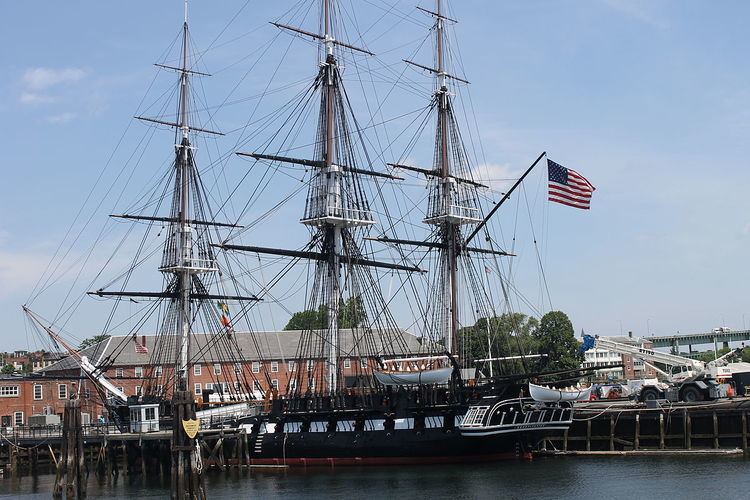Nationality American Occupation Shipwright | Name George Claghorn | |
 | ||
Known for Military service in the American Revolutionary War and as the master shipbuilder of the USS Constitution (Old Ironsides) Died February 3, 1824, Seekonk, Massachusetts, United States | ||
George claghorn
George Claghorn (July 17, 1748 [O.S. July 6, 1748] – February 3, 1824) was an American patriot and shipwright. He served as an officer and was wounded in the American Revolutionary War. After the war, he was awarded the rank of colonel in the Massachusetts militia. Claghorn was the master shipbuilder of the USS Constitution (a.k.a. "Old Ironsides"), which he built for the early United States Navy during the years 1794–97. The Constitution is the oldest naval vessel in the world that is still commissioned, afloat and seaworthy.
Contents
Personal life
Claghorn was born in 1748, the ninth child of Experience (Hawes) and Shubael Claghorn in Chilmark, Massachusetts on Martha's Vineyard. As a family name, Claghorn (also Cleghorn) appears in Scottish records as early as 1350 in Edinburgh, Cramond, Lothian and Corstorphine. His great-grandfather, James, had been brought to New England in 1650 as a prisoner of war during the Scottish Rebellion, following the Battle of Dunbar. Claghorn married Deborah Brownell of Dartmouth on December 20, 1769, and they had eight children. He died in 1824 in Seekonk, Massachusetts.
Military career
George Claghorn served in the Massachusetts militia during the American Revolution. He was shot and wounded in the knee at the battle of Bunker Hill. After the war, Claghorn was promoted to the rank of colonel in the militia.
Breed's Hill
Most of what is known as the "battle of Bunker Hill" was actually fought just less than a half mile away at Breed's Hill in the Charlestown section of Boston, Massachusetts. The battle was fought on June 17, 1775, during the Siege of Boston in the early stages of the American Revolutionary War. In that battle 450 American fighters were killed or wounded. After receiving a gunshot wound to the knee, Claghorn went on to lead his militia troops in more battles eventually attaining the rank of Major during the war.
Old Ironsides
The keel of the Constitution was laid down on November 1, 1794, at Edmund Hartt's shipyard in the North End of Boston, Massachusetts, under the supervision of Captain Samuel Nicholson and master shipbuilder, Colonel George Claghorn.
In March 1796, as construction slowly progressed, a peace accord was announced between the United States and Algiers and, in accordance with the Naval Act of 1794, construction was halted. After some debate and prompting by President Washington, Congress agreed to continue to fund the construction of the three ships nearest to completion: United States, Constellation, and Constitution. Constitution's launching ceremony on September 20, 1797, was attended by then President John Adams and Massachusetts Governor Increase Sumner. Upon launch, she slid down the ways only 27 feet (8.2 m) before stopping; her weight had caused the ways to settle into the ground, preventing further movement. An attempt two days later resulted in only an additional 31 feet (9.4 m) of travel before the ship again stopped. After a month of rebuilding the ways, Constitution finally slipped into Boston Harbor on October 21, 1797, with Captain James Sever breaking a bottle of Madeira wine on her bowsprit.
Constitution is a wooden-hulled, three-masted heavy frigate of the United States Navy, named by President George Washington after the Constitution of the United States of America. Launched in 1797, Constitution was one of six original frigates authorized for construction by the Naval Act of 1794 and the third constructed. Joshua Humphreys designed the frigates to be the young Navy's capital ships, and so Constitution and her sisters were larger and more heavily armed and built than standard frigates of the period. Her first duties with the newly formed U.S. Navy were to provide protection for American merchant shipping during the Quasi-War with France and to defeat the Barbary pirates in the First Barbary War.
Constitution is most famous for her actions during the War of 1812 against the United Kingdom, when she captured numerous merchant ships and defeated five British warships: HMS Guerriere, Java, Pictou, Cyane, and Levant. The battle with Guerriere earned her the nickname of "Old Ironsides" and public adoration that has repeatedly saved her from scrapping. She continued to serve as flagship in the Mediterranean and African squadrons, and circled the world in the 1840s. During the American Civil War, she served as a training ship for the United States Naval Academy. She carried US artwork and industrial displays to the Paris Exposition of 1878.
Retired from active service in 1881, Constitution served as a receiving ship until designated a museum ship in 1907. In 1934 she completed a three-year, 90-port tour of the nation. Constitution sailed under her own power for her 200th birthday in 1997, and again in August 2012, to commemorate the 200th anniversary of her victory over HMS Guerriere.
Constitution's stated mission today is to promote understanding of the Navy's role in war and peace through educational outreach, historic demonstration, and active participation in public events. As a fully commissioned US Navy ship, her crew of 60 officers and sailors participate in ceremonies, educational programs, and special events while keeping the ship open to visitors year round and providing free tours. The officers and crew are all active-duty US Navy personnel and the assignment is considered special duty in the Navy. Traditionally, command of the vessel is assigned to a Navy commander. Usually berthed at Pier 1 of the Boston Navy Yard (formerly the Charlestown Navy Yard), at one end of Boston's Freedom Trail, Old Ironsides entered Dry Dock 1 in the Boston Navy Yard on May 18, 2015, to begin a three-year restoration program.
